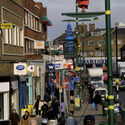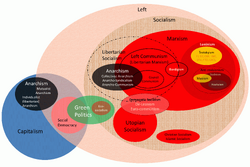
Green politics and religious socialism are not mutually exclusive with other left points of view. Author: Araz.

Watham Forest borough council in 2015.

Richmond upon Thames London Borough Council in 2015.

Croydon London Borough Council 2015.
London's economy folds up[]
The East End declines[]
Limehouse Basin was amongst the first docks to close in the late 1960s. later the docks also closed at Whapping and The Isle of Dogs. Other places like Whitechapple and Brick Lane were also in decline for other socio-economic reasons. By 1981, Limehouse had shared the London Docklands-wide physical, social and economic decline which led to the setting up of the London Docklands Development Corporation in these regions.
As industry continued to decline during the 1970s, Camden's population continued to decline, falling to 161,100 at the start of the 1980s.
The Camden markets, which started in 1973, when Camden Lock market proper started in a former timber-yard in 1973, and have now grown to 6 since then. The equily popular market in Inverness Steet is over 100 years old. Camden has now begun to rise again with new housing developments on brownfield sites and the release of railway and gas work lands around Kings Cross.
Other places like Whitechapple, Shadwell, the Isle of Dogs, Wapping, Beckton and the Greenwich Peninsular have been revitalised since the late 1970s.
The Bricklayers' Arms Flyover[]
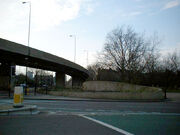
Bricklayers' Arms roundabout and flyover.
A flyover of the Bricklayers' Arms roundabout was built in the 1970s to cope with the increase in traffic in the area. Initially it consisted of two lanes for traffic, one into and one out of London; however, the London-bound lane was later closed after a number of head-on collisions on the flyover, which was hence reduced to east bound only route.
In the 1970s there was a plan by the Greater London Council for a road to go between the Bricklayers Arms roundabout and the northern entrance of the Blackwall Tunnel, crossing the Thames in two tunnels (one adjacent to Tower Bridge and providing a link to London Docklands.
The rather over generous proportions of the roundabout which includes pedestrian underpasses from the adjacent roads onto it was a result of London Underground route safeguarding for future proposals of an extension of the Bakerloo Line from its terminus at Elephant and Castle Tube Station along and under the main road route and thence underneath the trackways of the old main line station to join surface services at South Bermondsey station. The roundabout would have been the site of a station, similar in layout to that at Old Street. The route is still safeguarded but has no prominence in current proposals.
The pedestrian underpasses were not attractive and involved quite circuitous walks via the island, surfacing and descending again to the various entrances; in 2009 these were supplemented by Pelican Crossings at the junctions with New Kent and Old Kent Roads, introduced because pedestrians preferring to cross there were causing more accidents. In 2013 the underpasses were filled in and levelled becoming wider pavements at these points.
East India Dock closed in about 1976[]
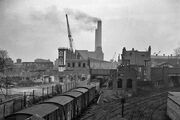
The site of Poplar Station. A view eastward, towards site of Blackwall terminus (now Brunswick Wharf Power Station); ex-Great Eastern, Fenchurch St. - Stepney - Millwall Junction - Blackwall line. This was the original rope-worked line of 1840 (steam locomotives from 1846): it lost its passenger service (Millwall Jct. - Blackwall) from 3/5/26 (goods at Blackwall end from 14/11/27, although freight continued to East India Dock until about 1976); the line curving right served the Midland Railway Dock. The Docklands Light Railway (Beckton and Woolwich branches) has been built since 1987 over part of this formation and this is now the site of Blackwall DLR station. Attribution: Ben Brooksbank.
Also See:How 6 East London railway stations are an analogy of London's East End!
East India Dock closed in about 1976 and many became both jobless and poor. The goods trains to Blackwall end from 14/11/27, although freight continued to East India Dock until about 1976); the line curving right served the Midland Railway Dock.
The Docklands Light Railway (Beckton and Woolwich branches) has been built since 1987 over part of this formation and this is now the site of Blackwall DLR station.
Recovery[]
The Docklands Light Railway (DLR) is an automated light metro system opened in 1987 to serve the redeveloped Docklands area of London and has grown vastly ever since.
The 2001 census gave Camden a population of 198,000, an accidental under count that was later revised to 202,600. The projected 2006 figure is 227,500.
Similar stories of decline and renewal hit other ex-industrial, dockland and mining regions in the UK like Manchester, Cardiff, Belfast and Glasgow at the same time.
London's political 'Loony Left'[]

Watham Forest borough council in 2015.

Tower Hamlets Borough council 2015.

Westminster council in 2015.

Lambeth Borough Council in 2015.

Bexley London Borough Council 2016.

Richmond upon Thames London Borough Council in 2015.

Croydon London Borough Council 2015.

Hillingdon London Borough council 2016.

Brent council in 2014.

Ealing London Borough Council in 2017.

Merton London Borough Council in 2017.
While academics have depicted the era as of the "new urban left" (such as with the rate-capping rebellion) as a throwback to earlier municipal militancy and poplarism, but wider media coverage tended to focus on the personalities of city leaders such as the Greater London Council's Ken Livingstone and Liverpool's Derek Hatton. When the Conservative government introduced "rate capping", Bernie Grant led the fight against it in the borough. This split the local Labour Party, but through this split Grant became the Borough of Haringey leader in 1985.
The Lambeth Borough leader 'Red' Ted night is often regarded as there spiritual founder. The Conservative Party and the popular tabloid press habitual mocked them and the GLC as part of a anti-Labour Party campaign run by the Conservatives (AKA- The Tories). Labour had got a firm control of Greater London and Liverpool, which it ran as de facto quasi independent states through out the late 1970s and early 1980s.
The British press accounts about the wider use of the nursery rhyme "Baa, Baa, White Sheep", renaming manhole covers, and "black bin-liner bags" were urban myths caused by outright fabrications by the gutter press. The reports that London councils had insisted that homosexuals be placed at the heads of the waiting lists for council housing and that London councils had spent £0.5 millions on "24 super-loos for gypsies" were found to be highly misleading upon investigation by the Media Research Group of Goldsmiths' College, University of London.
The 'Loony Left' were Labour councilors, party associations and MPs who were considered to be-
- Irrationally obsessed with minority and fringe issues,
- Paranoid about racial and sexual "problems" that are wholly imaginary on their parts and that have no real existence (see- Baa, Baa, White Sheep).
- Anti-Thacherite.
The accused councils[]
- Merseyside (Hard left)
- Liverpool (crooks/anti-Thacherite)
- South Yorkshire (Hard Left/anti-Thacherite)
- West Yorkshire (Hard Left/anti-Thacherite)
- Doncater (Hard Left/anti-Thacherite)
- Slough (anti-Thacherite)
- Reading (anti-Thacherite)
- Oxford (anti-Thacherite)
- Sandwell (Hard left)
- Dudley (anti-Thacherite)
- West Midlands (anti-Thacherite)
- Strathclyde (Hard left/quasi communist/anti-Thacherite)
- GLC/ILEA (Hard left)
- Basildon (Hard left/quasi communist)
- North Tyneside (Hard left)
- Newcastl upon Tyne (Hard left)
- Geatshead (Hard left)
- Suderland (Hard left)
- Teeside (anti-Thacherite)
- Humberside (anti-Thacherite)
- Kingston upon Hull (anti-Thacherite)
- Thamesdown (Hard left)
- Leicester (Asian Left)
- Glasgow (Hard left/quasi communist/anti-English/anti-Thacherite)
- Greater Manchester (Hard Left/anti-Thacherite)
- Sefton (anti-Thacherite)
- Bristol (anti-Thacherite)
- Lewisham (Loony Left/anti-Thacherite)
- Haringey (Loony Left/nti-Thacherite)
- Newham (Loony Left/anti-Thacherite)
- Sheffield (Hard left/anti-Thacherite)
- Tower Hamlets (Loony Left/anti-Thacherite)
- Hackney (Loony Left/anti-Thacherite)
- Southwark (Loony Left/anti-Thacherite)
- Islington (Loony Left/anti-Thacherite)
- Camden (Loony Left/anti-Thacherite)
- Greenwich (Hard Left/anti-Thacherite)
- Lambeth (Loony Left/anti-Thacherite)
- Coventry (Hard Left/anti-Thacherite)
- Birmingham (anti-Thacherite)
After the mellenium the Blairites came to prpomnance. Anti-sematitsum, black nationalisum, Scottish nationalisum, Irish Republicanisum, poltical Islam, radiacal anti-capitalist/globalisation, Ba'athisum and Islamisum then infected the Loony Left.
The "Baa, Baa, White sheep" issue[]

Baa Baa Black Sheep with Lyrics - Kids Songs and Nursery Rhymes by EFlashApps
Baa Baa Black Sheep with Lyrics - Kids Songs and Nursery Rhymes by EFlashApps.
The 1986 incident concerned the supposed possible (and false) coded racist meaning behind the nursery rhyme, which was originally made hundred of years ago to mock a medieval wool tax. The original story reported a Parent/Teacher Association (PTA) ban at Beevers Nursery, a privately run nursery school in the borough of Hackney. The loony Left Hackney council then offered them offical support and thought they were ideologically right.
It was originally reported by Bill Akass, then a journalist at the Daily Star newspaper, in the 15 February 1986 edition under the headline "Now it's Baa Baa Blank Sheep". Bill Akass had heard of a ban issued, by nursery school staff, on the singing of the nursery rhyme "Baa, Baa, Black Sheep", on the grounds that it was racist and portrayed black sheep (allegedly code fore Blacks) as subservient to the people (allegedly code for the mostly White general public). The press then entered a political feeding frenzy for literally anything they could find that was a anti-Labour/left-wing in nature, most of which was false!
In a unrelated incident at about this time, Brent Council also chose to appoint race-relations advisers to schools and Ealing offered the local gay community 'gay only' days at council run swimming pools and sports centers even though the local gays said they did not want or need it.
Here are some Baa, Baa, Black sheep variations.
Nuclear-free zones[]
By the late 1980s, Grater Manchester, Greater London, The London Borough Hounslow and the 'Loony Left' London boroughs in London; along with a few other rural counties (of which a few were Liberal, Independent and Conservative run) and boughs had declared them selves nuclear zones.
Life today[]
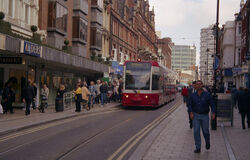
London has progressed greatly since the mid 1990s. George Street (West), Croydon The tram stop outside Allder's on George Street is one of the busiest on the system. In normal hours 20 to 30 trams an hour will serve this stop. Date-20 September 2001.
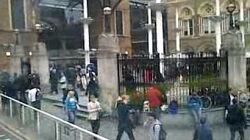
London Underground Strike 09 June 2009 1 2-0
London Underground Strike 09 June 2009 [1/2].
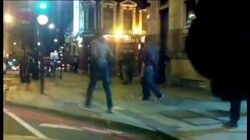
London Riots 2011 Our Crime
London Riots of 2011. [Our Crime ].Summer 2011's UK riots saw the biggest act of mass public criminality for a generation.
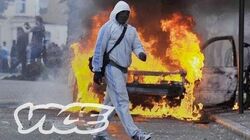
The 2011 Tottenham Riots
The 2011 Tottenham Riots.
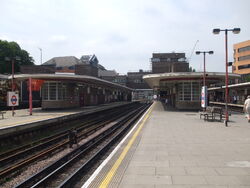
Northbound Metropolitan line Platform 3 looking north at Harrow-on the Hill Tube\Chlitern Rail Station. Chiltern railways platforms are on the left. Outer London has better railways, slightly less crime, better air quality, less crowded non-rush-hour streets and lower house prices.
There have been LUL and bus strikes since, and a mixture of anti-capitalists, ecologists, Reclaim the Streets, anti-Iraq war protesters, El Majaroon (a pro-Taliband lot) , the Countryside Alliance and ethnic minorities have rallied, marched, protested and rioted since, but is has never been as constant or bad as in the 1970s and 1980s.
The Camden markets, which started in 1973, when Camden Lock market proper started in a former timber-yard in 1973, and have now grown to 6 since then. The equily popular market in Inverness Steet is over 100 years old. Camden has now begun to rise again with new housing developments on brownfield sites and the release of railway and gas work lands around Kings Cross.
By 1981, Limehouse had shared the London Docklands-wide physical, social and economic decline which led to the setting up of the London Docklands Development Corporation in these regions. Other places like Whitechapple, Shadwell, the Isle of Dogs, Wapping, Beckton and the Greenwich Peninsular have been revitalised since the late 1970s. Sadly, most of the better property is now in the hands of rich incomers and not the locals.
The Docklands Light Railway (DLR) is an automated light metro system opened in 1987 to serve the redeveloped Docklands area of London and has grown vastly ever since.
The 2001 census gave Camden a population of 198,000, an accidental under count that was later revised to 202,600. The projected 2006 figure was 227,500 and the 2014 estimate was at 234,846.
In 2002, the Countryside Alliance organised the Liberty & Livelihood March, then the largest ever demonstration in British history, with almost half a million people marching through London to demonstrate against the proposed ban on fox hunting with hounds.
There were the horrific 7 July 2005 London bombings (AKA- The 7/7 attacks).
The scale of 10 Nov 2010 the London protest defied expectations, with as angry students rioted over tuition fees on the city's streets. 1 Dec 2010 was also chaotic as police arrested 153 people during clashes in London on the third day of protests against plans to raise student tuition fees. Several fires were lit, graffiti daubed on statues and missiles thrown at riot police.
The 6th to 16th of August 2011 UK wide riots started in Tottenham after a protest over the shooting of Mark Duggan protest turned ugly. Violence and looting spread across London and to other cities in England. Hackney to Croydon lay in ruins.
- Whilst every one involved dose not fully know what happened and are not unwilling to let on, it is true that the shooting was controversial! Afro-Caribbeans were angry with the police enquiery. They were concerned about a possible cover-up and held a rally outside the local police station turned ugly.
- Gangs began attacking any one who was not Black in Hackney LB, eastern Enfield LB and Hertfordshire's Broxtowe District. Wood Green's Tamils and Turks defended their shops. Soon, a multi-ethnic mayhem plundered and destroyed Central London and final burnt most of Croydon to the ground!
- The Police did a good job as did the variose local malitias (Siekh, Moslim, Chinese, Surrymen, Jewish, Somali, French, American, Aussie, Turkish, Irish, Indian, Sinhales, Tamils, football fans, Essexians, Hertfordians, native East Enders, Berkshiremen, the staff of a south London leasure center and the staff of an Ealing LB industrial park).
- Some major places like Newcatel-upon-Tyne, Exiter, Carliels, Belfast, Norwich, Hounslow LB, Sutton LB and Hillingdon LB were not ravished.
- Minor scuffles and odd acts of vandalism and/or arson hit Glasgow and Cardiff; along with several English places, including- St. Albans, Banbury, Worcester, Portsmouth, Reading, Oxford and Milton Keynes.
- Other notable armed risings were in-
- Salford- Hatred of Poles.
- Derby- General criminality.
- Nottingham- Theft by rich youngsters.
- Manchester- Peasants rebelling violently.
- Birmingham- Theft by rich youngsters.
- Liverpool- N/A.
- Toxtdith and near by places in the Liverpool Urban Area- N/A.
- Bristol- Hatred of a particular local Tesco shop. There was longstanding opposition to a Tesco Express store in Cheltenham Road, Stokes Croft, Bristol.
- West Bromwich and near by parts of the Black Country- Peasants rebelling violently.
- Coventry- General criminality.
- Wolverhampton- N/A.
- Lincoln- N/A.
- Gloucester- N/A.
- Gillingham- N/A.
- West Yorkshire County- N/A.
- 5 Nov 2014 saw officers in riot gear at a number of points later drew batons and clashed with various localised protests in the city.
- 1 November 2015 saw a band of 'Scumoween' ravers clash with London riot police.
Historic data for Camden, Newham, Hackney and Tower Hamlets LB[]
Population[]
| Year | Hackney. | Tower Hamlets | Newham | Camden |
|---|---|---|---|---|
| 1801 | 14,609 | 130,871 | 8,875 | 96,795 |
| 1811 | 19,523 | . | 11,166 | 124,741 |
| 1821 | 25,342 | . | 13,005 | 158,077 |
| 1831 | 35,482 | . | 15,553 | 192,228 |
| 1841 | 68,246 | . | 17,758 | 228,950 |
| 1851 | 94,961 | 330,548 | 24,875 | 270,197 |
| 1861 | 172,385 | . | 69,355 | 301,408 |
| 1871 | 249,810 | . | 113,835 | 332,619 |
| 1881 | 327,234 | . | 158,314 | 363830 |
| 1891 | 369,209 | . | 259,155 | 337,500 |
| 1901 | 374,132 | 578,143 | 338,506 | 362,581 |
| 1911 | 379,120 | 571,438 | 442,158 | 349,184 |
| 1921 | 368,469 | 529,114 | 448,081 | 335,408 |
| 1931 | 358,117 | 489,956 | 454,096 | 322,212 |
| 1941 | 305,501 | 337,774 | 377,508 | 286,956 |
| 1951 | 260,626 | 232,860 | 313,837 | 255558 |
| 1961 | 240,521 | 195,833 | 271,858 | 231,143 |
| 1971 | 221,975 | 164,699 | 235,496 | 209,097 |
| 1981 | 179,536 | 139,989 | 209,131 | 161,100 |
| 1991 | 187,792 | 167,985 | 221,146 | 181,489 |
| 2001 | 202,819 | 196,121 | 243,737 | 198,027 |
| 2011 | 213,573 | 254,096 | 307,984 | . |
Birth of Tower Hamlets[]

Dunbar Wharf and Dundee Wharf during Themes Path in the London Borough of Tower Hamlets, in the UK, during 2013.
The earliest apparent use of the name "Tower Hamlets" was in the 16th century, when the Constable of the Tower of London commanded the Tower Hamlet Militia as the Lord Lieutenant of Tower Hamlets.
Along Narrow Street, near Ropemakers Park and the 500 year old The Grapes pub, is and Sailmakers House. The wharf was once owned by the Dunbar family in the 19th century. The Dunbar family's wealth was initially from a Limehouse brewery that was established by Duncan Dunbar to make the alcoholic beverage called IPA.
The ships carried passengers and goods across the world as well as convicts to Australia The first voluntary emigrants to Australia also left from Dunbar Wharf in Poplar. The Western Times mentions one of the wharf's ships sinking on the 7th November 1865.
As the local 18th Century docks expanded, his son, also called Duncan, used the money he inherited from his father to build a new shipping business that was to be based at the new Dunbar Wharf.
Katharine Docks opened in 1827 and took their name from the former 12th century hospital of St. Katharine's by the Tower.
Dunbar Wharf was last surviving wharf in London’s docklands handling sacked goods, like juniper berries imported for the manufacture of gin. It was still operative in 1950, but closed by the time it was redeveloped in 1989 as a housing estate.
Diversity of Tower Hamlets[]
Tower Hamlets has one of the smallest indigenous populations of the boroughs in Britain. No ethnic group forms a majority of the population; a plurality of residents are of White ethnicity (45%) of which 31% are White British. Asians form 41% of the population, of which 32% are Bangladeshi which is the largest ethnic minority in the borough. A small proportion are of Black African and Caribbean descent (7%), with Somalis representing the second largest minority ethnic group. Those of mixed ethnic backgrounds form 4%, while other ethnic groups form 2%. The White British proportion was 31.2% in the 2011 census, falling from 42.9% in 2001.
As Tower Hamlets is considered as one of the world's most racially diverse zones, it holds various places of worship. According to the 2011 census, 34.5% of the population was Muslim, 27.1% Christian, 1.7% Hindu, 1.1% Buddhist, 1.1% followed other religions, 19.1% were not affiliated to a religion and 15.4% did not state their religion.
Hackney's demographics[]
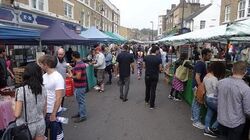
Walking around Broadway Market, Hackney, London - Saturday 6th September 2014
This is a walk through of this bustling market; taking in the wonderful sights & sounds - we only wish you could smell & taste some of the delicious food being offered by the many street food stalls.
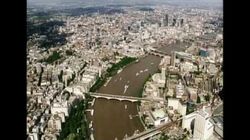
Hackney from the Air
Tony Robinson tells the story of Hackney from the air.
In 1801, the civil parishes that form the modern borough had a total population of 14,609. This rose steadily throughout the 19th century, as the district became built up; reaching 95,000 in the middle of that century. When the railways arrived the rate of population growth increased — reaching nearly 374,000 by the turn of the century. This increase in population peaked before World War I, falling slowly in the aftermath until World War II began an exodus from London towards the new towns under the Abercrombie Plan for London (1944). The population is now rising again, and the 2001 census gives Hackney a population of 202,824.
The population is ethnically diverse. Of the resident population, 89,490 (41%) people describe themselves as White British. 30,978 (14%) are in other White ethnic groups, 63,009 (29%) are Black or Black British, 20,000 (9%) are Asian or Asian British, 8,501 (4%) describe themselves as 'Mixed', and 6,432 (3%) as Chinese or Other.
There is also a large Turkish and Kurdish population resident in Hackney. Turkish and Kurdish communities are located in all parts of the borough, though there is a greater concentration in north and central Hackney.
132,931 (66%) of the resident population were British born. A further 10,095 (5%) were born in other parts of Europe, and the remaining 59,798 (29%) born elsewhere in the world.
The 2001 census also shows Christianity is the biggest religion in Hackney, with 44% of residents identifying Christian; 18% identified as Muslim, 4% Jewish, and 3% belonged to other religions. A further 19% stated no religion, and 12% did not state a response. By the 2011 census, residents identifying themselves as Christian fell to 38.6%, whilst those with no religion rose to 28.2%. Judaism had a modest increase, Islam had a small increase, and Hinduism made a slight drop.
The largest rise of ethnic groups between 2001 and 2011 was 'Other', which increased by 222%. This was followed by 'Mixed', which rose by 84%. At the 2011 census, 6.3% of the population was Jewish, making it the third biggest in England after London Borough of Barnet and the Hertsmere borough of Hertfordshire.
32% of households are owner–occupied.
The 2012 Summer Olympics and the 2012 Summer Paralympics[]
Queen Elizabeth Olympic Park, in London, United Kingdom, is a sporting complex built for the 2012 Summer Olympics and the 2012 Summer Paralympics, situated to the east of the city adjacent to the Stratford City development. It contains the athletes' Olympic Village and several of the sporting venues including the Olympic Stadium and London Aquatics Centre, besides the London Olympics Media Centre.
The park is overlooked by the ArcelorMittal Orbit, an observation tower and Britain's largest piece of public art. It was simply called Olympic Park during the Games but was later renamed to commemorate the Diamond Jubilee of Elizabeth II, (though it is not an official Royal Park of London). The park occupies an area straddling four east London boroughs; Newham, Tower Hamlets, Hackney and Waltham Forest. Part of the park reopened in July 2013, with a large majority of the rest (including the Aquatics Centre, Velopark and Orbit observation tower) reopening in April 2014.
Imaginary of the East End and environs[]
Videos[]
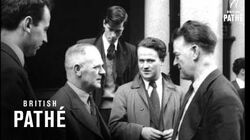
Rail Strike Negotiations (1955)
Rail Strike Negotiations (1955).
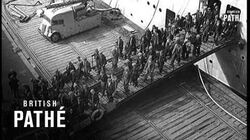
Rail Strike Threatens Industry (1955)
Rail Strike Threatens Industry (1955).
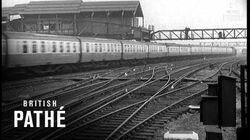
Running Again Aka Railways Back To Normal (1955)
Running Again Aka Railways Back To Normal (1955).
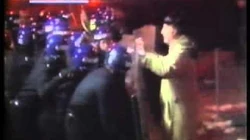
David johnston was attacked and stitched up the Wapping picket 1987
Mr David Johnston was attacked and stitched up the Wapping picket 1987

London Late 1940s in Colour... Georges Delerue (V.rare footage)
This is rare footage of St. John's Wood area of North West London from the late 1940s. The music is by Georges Delerue.

STREETS OF LONDON IN 1960's
STREETS OF LONDON IN 1960's.
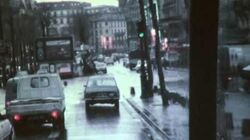
IN LONDON 1970's
LONDON IN THE 1970's.
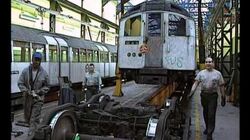
History Of London Underground-0
"History Of London Underground", a documentary about the history of the London Underground.
Also see[]
- CND
- The Paris riots of the 1960s
- Italy's Years of Lead
- IG Metall strikes between 1955 and 1985
- Kent State University vs. Ohio National Guardsmen
- Politically Communist and/or Socialist
- A political diorama
- RAF Molesworth
- RAF Upper Heyford
- Greenham Air Base
- "London's Burning" (the political epithet, not the UK TV show)
- Racial conflict in London (1959-1982)
- Baa, Baa, Black sheep variations
- London's covert kinky and illegal sex life
- A political diorama
- How 6 London and Blackwall Railway stations are an analogy of London's East End!
- UK media bias 1991-2017
- The 1950 United Kingdom general election
- Lord Louis Mountbatten's very British coup
Links[]
- https://dunbarwharflondon.com/about/
- https://commons.wikimedia.org/wiki/File:Dunbar_Wharf_and_Wundee_Wharf_in_the_London_Borough_of_Tower_Hamlets_from_the_Thames_Path,_Spring_2013_(1).jpg
- https://dunbarwharflondon.com/about/
- https://dunbarwharflondon.com/
- http://www.merchantnetworks.com.au/periods/1800after/1800dunbar.htm
- http://dunbar-wharf.com/
- https://www.flickr.com/photos/richardandgill/563364572/
- http://alondoninheritance.com/london-journeys/history-of-whitechapel-and-limehouse/
- http://www.alamy.com/stock-photo-riverside-view-of-dunbar-wharf-narrow-street-london-c1945-c1965-artist-28056043.html
- https://isleofdogslife.wordpress.com/2013/05/24/another-time-at-the-grapes-new-thames-sculpture-in-limehouse/
- http://www.thegrapes.co.uk/history.php
- https://starfishingtravels.wordpress.com/2013/10/26/back-lanes-thames-path-limehouse-to-wapping/
- https://www.pinterest.com/pin/557672366331735079/
- http://media-cache-ec0.pinimg.com/736x/11/98/6d/11986d8a263cf0b4b05503773177f2d2.jpg
- http://bufvc.ac.uk/dvdfind/index.php/title/6133
- https://en.wikipedia.org/wiki/St_Katharine_Docks
- http://www.wikiwand.com/en/1981_Brixton_riot
- http://www.urban75.org/brixton/history/riot.html
- http://www.wikiwand.com/en/1981_England_riots
- http://www.theguardian.com/uk/picture/2013/apr/11/brixton-riots-1981-margaret-thatcher
- http://www.wikiwand.com/en/Royal_Borough_of_Kensington_and_Chelsea
- http://www.wikiwand.com/en/West_End_of_London
- http://www.wikiwand.com/en/Camden_Market Camden markets
- http://www.wikiwand.com/en/London_Borough_of_Camden
- http://www.wikiwand.com/en/City_of_Westminster
- http://www.wikiwand.com/en/Soho
- http://www.wikiwand.com/en/Lambeth_London_Borough_Council
- http://www.wikiwand.com/en/London_Borough_of_Richmond_upon_Thames
- http://www.wikiwand.com/en/Poll_Tax_Riots
- http://www.wikiwand.com/en/Kray_twins
- http://www.wikiwand.com/en/Special_Patrol_Group
- http://www.wikiwand.com/en/Death_of_Blair_Peach
- http://www.wikiwand.com/en/Notting_Hill_Carnival
- http://www.wikiwand.com/en/Clerkenwell
- http://www.wikiwand.com/en/British_African-Caribbean_people
- http://www.bbc.co.uk/london/content/image_galleries/london_thru_lens_gallery.shtml?14
- http://www.wikiwand.com/en/British_Movement
- http://www.corbisimages.com/stock-photo/rights-managed/HU007879/british-movement-march-through-london
- http://bussongs.com/songs/baa-baa-white-sheep.php
- http://www.wikiwand.com/en/Black_sheep
- http://bussongs.com/songs/baa-baa-black-sheep.php
- http://www.wikiwand.com/en/Baa,_Baa,_Black_Sheep
- http://www.wikiwand.com/en/Paedophile_Information_Exchange
- http://www.wikiwand.com/en/Loony_left
- https://en.wikipedia.org/wiki/Loony_left
- https://en.wikipedia.org/wiki/Sus_law
- http://averypublicsociologist.blogspot.co.uk/2015/02/labour-vs-militant-tendency.html
- https://en.wikipedia.org/wiki/Ted_Knight_(politician)
- http://www.independent.co.uk/news/the-rise-and-fall-of-red-teds-loony-lefties-1593657.html
- http://bussongs.com/songs/baa-baa-white-sheep.php
- http://www.theguardian.com/world/2008/may/21/1968theyearofrevolt.antiwar
- http://news.bbc.co.uk/onthisday/hi/witness/march/17/newsid_4090000/4090886.stm
- http://www.wikiwand.com/en/Death_of_Blair_Peach
- http://www.magnumphotos.com/Catalogue/David-Hurn/1968/GB-London-Anti-Vietnam-War-Riots-1968-NN162836.html
- https://uk.news.yahoo.com/on-this-day--thousands-of-anti-vietnam-protesters-clash-with-police-in-london-161217942.html
- http://www.wikiwand.com/en/Shirley_Porter
- http://www.wikiwand.com/en/Nuclear-free_zone
- http://www.wikiwand.com/en/Homes_for_votes_scandal
- http://www.wikiwand.com/en/Shirley_Porter
- http://www.conservapedia.com/Winter_of_Discontent
- http://www.businessinsider.com/thatcher-and-the-winter-of-discontent-2013-4#ixzz3iAINpK00
- http://www.wikiwand.com/en/Winter_of_Discontent
- http://www.businessinsider.com/thatcher-and-the-winter-of-discontent-2013-4?IR=T
- http://www.wikiwand.com/en/Hunting_Act_2004
- http://www.wikiwand.com/en/Poll_Tax_Riots
- http://www.wikiwand.com/en/Countryside_Alliance
- http://www.theguardian.com/world/2008/may/21/1968theyearofrevolt.antiwar
- http://news.bbc.co.uk/onthisday/hi/witness/march/17/newsid_4090000/4090886.stm
- http://www.wikiwand.com/en/Death_of_Blair_Peach
- http://www.wikiwand.com/en/Limehouse
- http://www.wikiwand.com/en/History_of_Bangladeshis_in_the_United_Kingdom
- http://news.bbc.co.uk/1/hi/magazine/6729683.stm
- http://www.wikiwand.com/en/Brick_Lane
- http://news.bbc.co.uk/1/hi/magazine/6729683.stm
- http://www.wikiwand.com/en/Lambeth_London_Borough_Council
- http://www.wikiwand.com/en/Edward_Heath
- http://www.telegraph.co.uk/news/uknews/road-and-rail-transport/10794806/Tube-strike-London-Underground-live.html
- http://www.digplanet.com/wiki/Category:UK_miners%27_strike_%281984%E2%80%9385%29
- http://boards.straightdope.com/sdmb/archive/index.php/t-522009.html
- http://wn.com/uk_miners_strike_1984_85
- http://www.wapping-dispute.org.uk/
- http://us.wow.com/wiki/UK_miners%27_strike_(1984%E2%80%931985)
- https://en.wikipedia.org/wiki/British_Bangladeshi#History
- https://en.wikipedia.org/wiki/Death_of_Keith_Blakelock
- https://en.wikipedia.org/wiki/UK_miners'_strike_(1984–85)
- https://en.wikipedia.org/wiki/Three-Day_Week#Background
- http://www.wikiwand.com/en/1981_Brixton_riot
- http://www.urban75.org/brixton/history/riot.html
- http://www.wikiwand.com/en/1981_England_riots
- http://www.theguardian.com/uk/picture/2013/apr/11/brixton-riots-1981-margaret-thatcher
- http://www.wikiwand.com/en/Royal_Borough_of_Kensington_and_Chelsea
- http://www.wikiwand.com/en/Bernie_Grant






